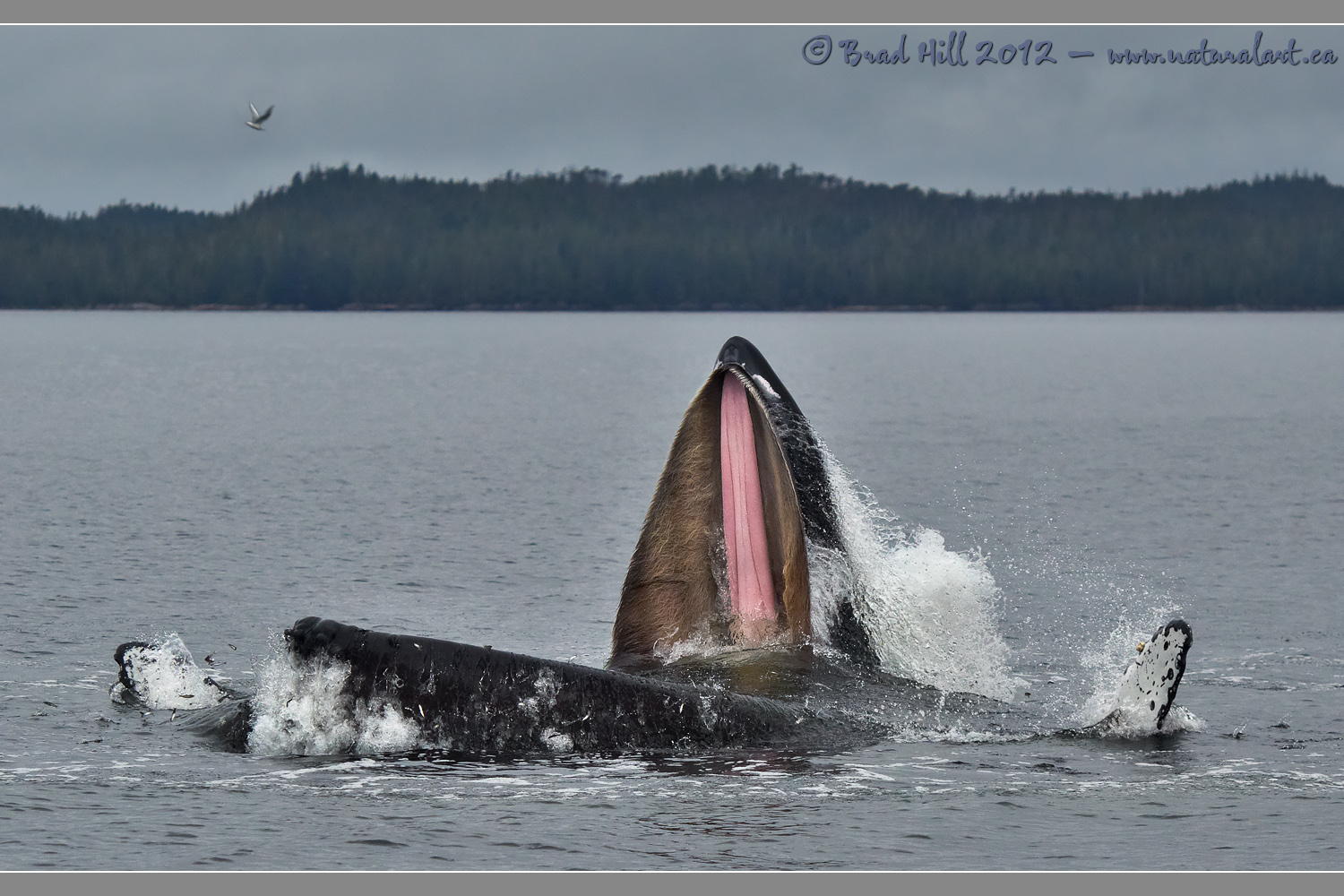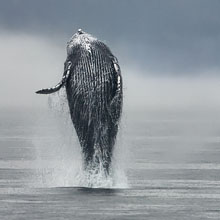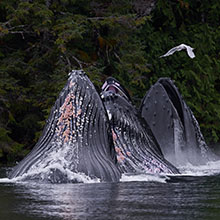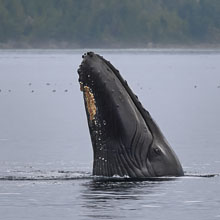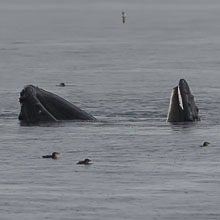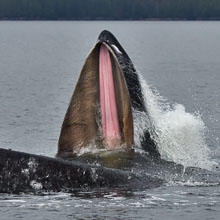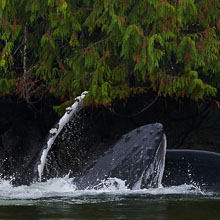Availability: Undetermined - Enquiries?
In the Field
Emergent Ocean Orchid? Waters of Great Bear Rainforest (on northern BC Coast), BC, Canada. October 6, 2011.
Nothing can change a dreary, rainy day in the waters of the Great Bear Rainforest faster than having an "Ocean Orchid" sprout out of the waters right beside your boat! And that's the first thought I had when this humpback whale rose up and gulped a huge mouthful of tiny fish and whatever else was in the water right then - that for an instant it looked like a giant flower blooming! In this case, though, the pinkish band that looks like a pollen guide is actually part of the palette found on the roof of its mouth.
Humpback whales have the proportionately longest pectoral fins of any cetacean (whale) - in this image they're seen emerging from the water on the lateral sides of the mouth and appear to be being used to help form a "cup" or "scoop" to help channel the water and fish that will be filtered through the baleen plates into its mouth. The two most popular theories to explain why such large pectoral fins are advantageous to humpbacks are that they may provide for higher maneuverability or that they might be important in temperature regulation (through providing for increased surface area) when migrating from warm to cold waters. While these theories may seem logical, one wonders why increased maneuverability or temperature regulation might not be advantageous to other whales that migrate over a similar range, such as gray whales. Perhaps what we're looking at here - the use of the pectoral fins as an aid to the unique way a humpback feeds - might just be an equally plausible explanation as to why it's advantageous to humpbacks to have those huge pectoral fins.
It seems we hear more and more about the devastating effect that humans are having on so many species of wildlife. If you look back a century or so one could find a sad story about the humpback whale as well - through relentless pursuit of whale oil and baleen we hunted them to near extinction. But strict anti-whaling legislation (that MOST of the world has respected) and passing time have resulted in a significant bounce-back of the humpback populations in the Pacific - even in the last 10 years there's been a noticeable increase in humpbacks frequenting the waters of the Great Bear Rainforest along the west coast of British Columbia. It gives one hope that humans CAN do the right thing and that it isn't too late to save species currently on the brink.
For those wanting to see some detail in those tiny bait-fish - here's a 2400 pixel version of it for you to view:
• Emergent Ocean Orchid? Download 2400 pixel image (JPEG: 1.3 MB)
ADDITIONAL NOTES:
NOTE 1: This image - in all resolutions - is protected by copyright. I'm fine with personal uses of it (including use as desktop backgrounds or screensavers on your own computer), but unauthorized commercial use of the image is prohibited by law. Thanks in advance for respecting my copyright!
NOTE 2: Like all wildlife photographs on this website, this image was captured following the strict ethical guidelines described in The Wildlife FIRST! Principles of Photographer Conduct. I encourage all wildlife photographers to always put the welfare of their subjects above the value of their photographs.
NOTE 3: This image was captured during one of my "Into the Great Bear Rainforest" photo tours in the autumn of 2011. Each year I offer trips into two different parts of the Great Bear Rainforest as well as one to photograph aquatic mammals and oceanscapes near the northern tip of Vancouver Island. And, in selected years, I also offer photo tours to locations to capture other highly sought-after subjects, such as various owl species of the boreal forest and wildlife of Canada's Arctic. Details about these trips can be found on the Photo Tours page of this website.
Behind the Camera
Emergent Ocean Orchid? Waters of Great Bear Rainforest (on northern BC Coast), BC, Canada. October 6, 2011.
Digital Capture; RAW 14-bit format; ISO 500.
Nikon D7000 with Nikkor 70-200mm f2.8 VRII lens @ 112mm (168mm EFL) - hand held. VR on and in "Normal" mode.
1/1250s @ f4.0; -0.33 stop compensation from matrix-metered exposure setting.
At the Computer
Emergent Ocean Orchid? Waters of Great Bear Rainforest (on northern BC Coast), BC, Canada. October 6, 2011.
RAW Conversion to 16-bit TIFF, including first-pass/capture sharpening using Phase One's Capture One Pro 6. A total of three raw variants from the original raw file - two which were different in exposure (from +0.9 stop above original exposure to +1.2 stops above original exposure) and all three converted using different white balances (one "as shot", one slightly cooler (-300k) than original capture and one slightly warmer (+400k) than original capture. Yes, this was a tricky image to process! ;-)
Further digital corrections on resulting 16-bit TIFF files using Adobe's Photoshop CS5 and Light Craft's Lightzone. Photoshop adjustments including compositing (via layering and masking, including the use of multiple luminosity masks) the exposure/white balance variants, selective colour saturation AND desaturation, and selective sharpening for web output. Final tone tweaking performed using tonemapper/re-light in Lightzone.
Conservation
Emergent Ocean Orchid? Waters of Great Bear Rainforest (on northern BC Coast), BC, Canada. October 6, 2011.
Ten percent of the revenue generated by this image will be donated to Raincoast.
Species Status in Canada*: Threatened - North Pacific population (May 2003).
Humpback Whales (Megaptera novaeagnliae) are active, acrobatic whales that can throw themselves completely clear of the water (a behaviour known as breaching) and will swim on their backs with both flippers in the air. Humpbacks are large (up to 14m - or 46 feet - in length and 40 tonnes in weight) and with huge flippers.
Humpbacks are found in tropical, temperate, and sub-polar waters around the world. They are found on both the east and west coasts of North America. The North Pacific population has been estimated at between 6,000 and 8,000 individuals, but only a few hundred of these are found in the waters off the coast of British Columbia.
While Humpbacks are recovering from the damage done to their populations by commercial fishing, the are still subject to a variety of threats from human activities, including becoming entangled in fishing nets, noise and chemical pollution and habitat destruction.
These two Humpback Whales were photographed along the coast in British Columbia's Great Bear Rainforest. The Raincoast Conservation Society is fighting to protect the Great Bear Rainforest along the central and northern coast of British Columbia. This unique ecosystem harbours a strong population of many high-profile species such as Brown Bears and Gray wolves, plus many aquatic species that serve as prey for the Humpback Whale. If you are looking for a meaningful way to contribute to the conservation of the Great Bear Rainforest and all its associated species, Raincoast will provide maximal "bang" for your conservation dollars.
For more information on the status of Humpback Whales in Canada, go to: http://www.speciesatrisk.gc.ca and search under "Humpback Whale".
*as determined by COSEWIC: The Committee on the Status of Endangered Wildlife in Canada












